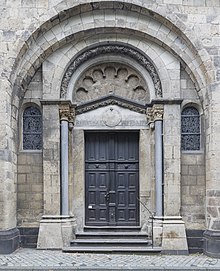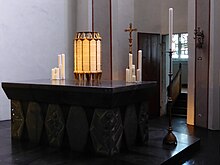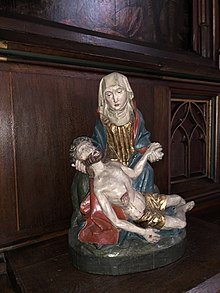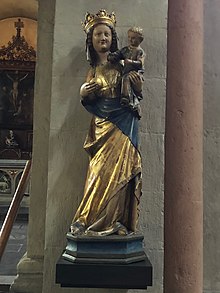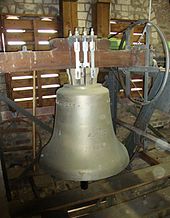St. Maria in Lyskirchen
St. Maria in Lyskirchen is the smallest of the twelve large Romanesque basilicas in Cologne's old town . The Roman Catholic parish church belongs to the Archdiocese of Cologne and is located in the south of the old town . It was built in its current form as a three-aisled gallery basilica oriented towards St. Kunibert between 1198/1200 and 1225. St. Maria in Lyskirchen is particularly characterized by historical vault frescos from the 13th century, which are the only one of the twelve to be largely preserved , and the adoration of the sailor's Madonna . The name Lyskirchen is probably derived from a Mr. Lisolvus or Lysolfus, who built the original building as a separate church . Both the church and the adjoining sexton's house and the sacristy are under monument protection .
history

According to legend, the church was founded by Bishop Maternus in the early fourth century. In 948 a private Lady Chapel in the form of a simple hall church was first mentioned in a document. It was probably a private church belonging to Mr. Lisolvus or Lysolfus, who lived in a house immediately north of the chapel. The name “Lisolfikyrken” eventually evolved into “Lyskirchen”. The building was incorporated in 1067 by Archbishop Anno II into the canon monastery of St. Georg, which he founded, as a parish church and was then called St. Maria in Noithusen . Located in the immediate vicinity of the Rhine and south of the city wall , which was expanded in 1106 , it was primarily used by skippers for prayer. In the 12th century it was probably expanded to have three aisles and was first mentioned in a document around 1135/42 as "ecclesia Lisolvi" (Church of Lisolvus) . Archaeological investigations have only provided little information about this previous building. The church of Lisolvus became the parish church of the fishing village No (i) thusen, which was added to the Cologne city expansion in 1106 and was later called Airsbach. The Lyskirchen patrician family lived in the immediate vicinity and subsequently contributed to the further expansion of the church as a donor . The construction of St. Maria in Lyskirchen in its present form began between 1198 and 1200. Due to the constant risk of flooding, the building site was previously increased. Around 1225 the church was completed as a gallery basilica with a slightly irregular floor plan and, based on St. Kunibert and St. Severin, received a two-tower east building with an apse in between to accentuate the church towards the Rhine. Probably due to lack of money, only the north tower was completed. The crypt of the previous church was abandoned and the new one was limited to the space under the choir square and apse.
Around 1520/30 the fan-shaped windows, with the exception of those in the galleries, were replaced by pointed arch windows with fish-bubble tracery, with the windows in the apse having two-lane tracery. In addition, the side aisles were given buttresses on the outside and the west facade was given a gable that integrated all three aisles . In 1528 the name St. Maria in Lyskirchen was used for the first time. In the years 1658 to 1662, St. Maria in Lyskirchen underwent an extensive renovation of the interior, in which the apse was raised and blind arches , panel frieze and dwarf gallery were replaced by high Gothic tracery windows . For this purpose, the vaults of the choir and apse were removed and their ceiling height adjusted to that of the central nave. As a result of these alterations, the apse lost its semicircular shape and turned out to be polygonal . In the galleries, arched arcades made of baroque balusters took the place of the triple arcades , so that the tall nave walls of the two eastern bays opened in full width, while the original triple arches were preserved in the western bay. A baroque high altar was entered in the choir in 1663/65 , of which only the statues of St. Nicholas and Maternus are preserved today. The Romanesque windows of the galleries were renewed in 1697 as arched windows with fork tracery. The church tower was given a folding helmet, which was replaced by a rhombic roof in the 19th century . In addition, the church was painted white in the 17th century.
During the floods in 1784 , the floods and ice drift destroyed part of the church furnishings, so that in 1785 a new high altar had to be built. When the Canon Monastery of St. Georg was secularized in 1804 , St. Maria in Lyskirchen became a parish church . From 1850 the building became increasingly in need of renovation . In 1860 the choir got a new high altar designed by Vincenz Statz . In addition, the apse windows were decorated with stained glass until 1865 and altars were placed in the choir chapels. An extensive restoration took place between 1868 and 1876, partially unifying the building in the Romanesque style, for example in the newly designed west facade or the gallery windows. When the interior was refurbished in 1879, the whitewashed vault fresco from the 13th century was discovered. The medieval ceiling paintings were restored by 1881 and, like the entire interior, additionally painted over by Matthias Goebbels in the style of historicism . The construction work in the early 20th century concerned the crypt in 1918 and the exterior in 1928/30. From 1934 the medieval frescoes were restored again, during which the historicist painting from the 19th century, which no longer corresponded to contemporary tastes, was removed and replaced with a new one by Anton Bardenhewer. The painting by Goebbels was only preserved in the north and south tower chapels. Except for the tower, the Allied air raids in 1942/43 destroyed all the other roofs of St. Maria in Lyskirchen. The barrel vault of the galleries collapsed , but the central nave vault with its painting remained undamaged. The reconstruction of the church after the Second World War began in 1947 and lasted until 1962. From 1972 to 1977 the medieval vault frescos were again restored, with all later overpaintings being removed. From 1982 to 1989 St. Maria in Lyskirchen was plastered in pink, gray and white on the outside according to original findings from the Romanesque period . From 1982 the church and later the sexton's house and sacristy were included as architectural monuments in the corresponding list for the district of Altstadt-Süd .
Building description
St. Maria in Lyskirchen has the shape of a uniformly vaulted gallery basilica. The nave is short and has three bays. It consists of a central and two side aisles. The choir is framed by a semicircular east apse and two side chapels, above which a tower rises to the north.
Exterior construction
St. Maria in Lyskirchen is the smallest of the twelve large Romanesque churches in Cologne and a church building typical of the Staufer era. Formative for this style, which can be found in many parish churches of the late Romanesque in the Rhineland, was the nave of St. Ursula . The north tower of the east section follows the example of St. Aposteln : In the 19th century, a Rhenish helmet was designed from the original folding helmet .
On the west facade, the upper parts of which were redesigned in the 19th century, one of Cologne's most idiosyncratic portals has been preserved: The arched field framed by a garland above the column-flanked gable lintel gate shows a blind jagged arch, its closest relatives in the west porch of St. Andreas and can be found in the fan windows of St. Gereon . There is a marking above the lintel showing the high water level of the "ice flood" of February 28, 1784. Overall, with the multitude of figurative representations, it is the most elaborately designed portal of all Romanesque churches in Cologne.
In the base of the sexton's house , which adjoins the church to the east, part of the city wall extension from 1106 has been preserved.
inner space
The two tower chapels open to the north and south of the choir square. Behind the east apse is an apseid which forms the sacristy . The crypt is located under the choir square and the east apse.
Vault paintings
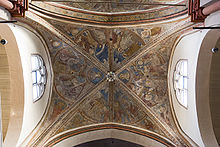
St. Maria in Lyskirchen is the only one of the twelve large Romanesque churches in Cologne whose frescoes have largely been preserved. In the three central nave bays, which were painted around 1250, four scenes of the Old (each north) and four scenes of the New Testament (each south) are shown in pairs in mutual relation and narrative progressing from east to west, whereby the Old Testament is based on its function as New Testament prophecy was reduced:
- The promise of Isaac and the Annunciation .
- Birth of Isaac and Birth of Christ .
- Offering of Samuel and the twelve year old Jesus in the temple .
- Bath of Naaman and baptism of Jesus .
- Moses brings the Ten Commandments and the Transfiguration of Christ .
- Entry of Solomon into Israel and entry of Jesus into Jerusalem .
- Supper of Ahasuerus and Lord's Supper .
- Job in misery and scourging of Jesus.
- Adoration and Destruction of the Brazen Serpent and the Descent from the Cross .
- Samson with the gates of the city of Gaza and Jesus' descent into hell .
- Ascension of the prophet Elias and rapture of Enoch as well as the ascension of Christ .
- Judgment of God on Carmel and the miracle of Pentecost .
The frescoes created in 1270/80 in the two choir chapels are also preserved:
- The vault painting of the southern choir chapel was created around the year 1270 and depicts the legend of the saints Nicholas of Myra as an eight-part cycle of pictures, with each of the four vault caps being bisected by a painted column. They address three miracles from the life of Nicholas.
- The ceiling fresco of the northern choir chapel was created a little later than that of the southern chapel, probably around 1280. As an eight-part cycle of pictures, it depicts scenes from the life of St. Catherine of Alexandria . This vault painting is the only one in St. Maria in Lyskirchen that is still in is in the state of restoration and overpainting from 1879, which is characterized by dark colors and extensive use of gold bronze .
The respective scenes are explained by writing tapes and are arranged radially in the ribbed vaults , so that the illusion of a dome is created. In the spandrels , saints in the south and prophets in the north complement the pictorial program. It is certain that there were figural paintings on the walls and probably also in the choir.
Furnishing
Fresco over the west portal
The Adoration of the Kings is the only mural of St. Maria in Lyskirchen, which is probably extensively painted in the Romanesque style, above the west portal. This fresco was only discovered in 1947 and was created around 1220/30 as a flat-arched tympanum . In the center of the picture is Mary with the baby Jesus sitting on a throne , who is approached from the left in adoration by the Three Kings . On the right there are two male figures that cannot be exactly assigned. Maybe they are prophets . This oldest painting in the church is in the hollow style, which can be recognized by the wrinkles on the clothing and can be found, for example, in the glass windows of St. Kunibert. The later created vault frescos were already made in the following serrated style .
Skipper Madonna
St. Maria in Lyskirchen is also called the Schifferkirche because the late Gothic Schiffer Madonna is venerated there. It stands on the inner west wall north of the entrance portal, was created around 1410/20 in the Rhineland and is over 2 meters tall. It probably came to St. Maria in Lyskirchen at the beginning of the 19th century and may have come from the Cistercian monastery in Walberberg . The Schiffer Madonna shows a strong correspondence to the Beautiful Madonna in St. Foillan in Aachen and, like this, is made in the soft style of the Bohemian type. Characteristic features include the child Jesus facing the viewer, who seems to be offering a small apple, as well as the shaping of the Madonna's garment, the hems of which cascade down on her right in long strips and on the left. The figure was placed on the outside of the east apse until 1868, which probably led to the historically incorrect assumption that it was particularly venerated by Rhine boatmen, from which the name Schiffermadonna arose. The related conviction that St. Maria in Lyskirchen was the church of the boatmen is also unfounded. Although some boatmen lived in the Veedel around the church since the late Middle Ages, a corresponding guild and a brotherhood of St. Nicholas did not emerge until the 17th century. The statue stands in a wall niche painted by Peter Hecker , which shows boatmen looking up at the Madonna.
Baptismal font
There is a baptismal font on the inner west wall south of the entrance portal . This dates from the second half of the 13th century and is therefore the only remaining piece of equipment from the Romanesque, along with the frescoes. The octagonal baptismal font, widening towards the top, is made of Namur bluestone and is 1.02 m high. It rests on an octagonal central support with eight columns made of light marble. The eight sides of the baptismal font are decorated with three-pass arches , while at the level of the upper edge the eight corners are emphasized by decorative heads with notched faces. The font was a type that was widespread in the Lower Rhine at the time .
Church window
The three leaded glass windows in the north aisle, which date from around 1520/30, are historically significant . The stained glass in the middle, three-lane window shows the crucifixion of Christ . In the middle panel is the cross that embraces the richly dressed Maria Magdalena . Maria and Johannes are standing on the lanes to the left and right of it . The entire scene takes place against a uniform landscape background, while the figures are painted in the late Gothic style and have particularly differentiated faces and robes. The three images are each framed by ornamentation in the form of classic columns and flat arches, which combine elements of the Gothic and Renaissance styles typical of the time . Small angels bear the coats of arms above the capitals of the left and right panels.
The likewise three-lane east window, which was made around 1520/30, shows St. Helena with the rediscovered cross of Christ , Maternus and St. Gereon with flag and shield. The three pictures are each framed by columns, the capitals of which are decorated with acanthus ornaments. In contrast to the middle window, the stylistic devices of the Renaissance are not supplemented by Gothic elements and the figures seem to be more based on contemporary Italian models than in the neighboring window to the west.
The three windows of the east apse were created in 1987 by Hans Lünenborg . The northeast window shows the Cologne bishop saints Agilolf , Anno , Brun , Engelbert , Everigisil , Heribert , Kunibert , Maternus and Severin . The middle one shows the Assumption of the Virgin Mary and the southeastern Nikolaus von Myra with bread basket and ship.
Statue of Saint Maternus
On the north wall of the nave between the second and third yoke is a wooden sculpture of St. Maternus with two mitres at hand. It probably comes from the former baroque high altar from 1665, which was destroyed during the floods in 1784, and is attributed to the circle of the artist Jeremias Geisselbrunn. Set in white with gilded borders and ornaments since 1975, nothing is known about its original color. After the removal of the following altarpiece in 1860, it remained with a sculpture of St. Nicholas, which is no longer in the church, as a remnant of the original baroque high altar.
Treasure showcase
In 2014, a treasure showcase was built into a wall niche of the northern choir chapel, which exhibits four pieces, some of which are related to the history of the community:
- an anointing oil vessel that was made around 1500 in a Cologne workshop and shows St. James above .
- the so-called Apostle Chalice. This was made in Cologne around 1695 and comes from the Servitinnenkloster St. Lucia , which stood in the Filzengraben and was dissolved during the secularization under Napoleon . A wealthy widow passed some of the church treasures from this monastery into the possession of St. Maria in Lyskirchen. The four evangelists with their respective attributes are depicted at the foot of the chalice . Above it, the apostles can be seen at the Lord's Supper.
- a measuring tray with a jug for wine and water. This was created in Cologne in 1795 and shows Maternus. According to legend, he had his monastery cell where the crypt of St. Maria in Lyskirchen is today.
- a monstrance rays in the center of the treasure showcase. This was made in Cologne in 1763. It deals with the Eucharist and shows, among other things, ears of wheat and grapes as a reference to the bread and wine of the Last Supper. At the top is a globe depicting the fall of man . Furthermore, a cross can be seen, which is erected on a lamb, which is the symbol of Agnus Dei .
The most valuable church treasure of St. Maria in Lyskirchen, the lecture cross known as the Salier Cross from the 12th century, is kept in a parish depot for security reasons. In the liturgy it is only used on solemn festivals .
Triptych Lamentation of Christ
There is a triptych in the northeast corner of the north aisle . It is a copy of the three-part painting by Joos van Cleve , which, according to the inscription , was donated in 1524 by the councilor Gobelinus Schmitgen. The original was sold by the municipality in 1812 and is now in the Städel Art Institute . The copy was made by Benedikt Beckenkamp and replaced the original in the same place after a few years. The middle wing shows the Lamentation of Christ . In addition to Maria, Nicodemus , Johannes and Maria Magdalena, an unknown man is depicted who is probably one of the donors of the retable . On the front side wings of the triptych, Saint Veronica with the handkerchief of Christ and Joseph of Arimathäa with the crown of thorns are depicted.
Triptych crucifixion of Christ
In the north choir side chapel there is another triptych to the east, which depicts the crucifixion of Christ and dates from the 17th century. The style of Christ looking upwards is based on a picture by Gortzius Geldorp from 1602, which hangs in the Senate Hall of Cologne City Hall . The founder of the triptych is shown on the left side wing. The small Pietà under the central wing was made around 1480.
Statue of the Madonna in the high altar retable
In the no longer preserved high altar retable was a 1.15 m high statue of the Madonna with a child, which still has its old frame. The wood carving figure was probably made in Cologne and dates from the second quarter of the 14th century. The Madonna, whose mantle is rather simple, was given to the church by Catharina Pütz in 1885. Today the statue stands in front of the northwest column of the choir square and looks to the west.
Choir stalls and miraculous image of the Annunciation
In the south-east corner of the south side chapel there is a choir stalls made in 1520 . The three-part row of seats originally comes from the monastery of St. Lucia, which was dissolved in 1802 . The copy of a painting from Santissima Annunziata in Florence hangs on the north wall of the choir from this monastery . The miraculous image represents the Annunciation and was created in the middle of the 17th century.
organ
In 1957 the church received an organ made by Romanus Seifert with 20 stops, divided into two manuals and a pedal. It stands on a gallery that was built around 1750. In 1880 Goebbels painted the gallery with angels making music.
Bells and tower clock
Before the First World War, the church had a three-bell ring, cast in 1817 by Peter Boitel of Bourmont. The great bell, weighing 1,528 pounds and dedicated to Our Lady , was cast over in 1870 while retaining the inscription. The middle bell, weighing 1,112 pounds, was dedicated to St. Maternus, the small bell, weighing 808 pounds, was dedicated to St. Nicholas . This bell had to be given in the First World War. Only a few years later, in 1919, Ernst Karl Otto from the Otto bell foundry in Hemelingen / Bremen cast a new bell with a total weight of around 48 quintals, consisting of four bells with the chimes: f '- as' - b' - as ". Of these, only the middle as'-bell, consecrated to the Mother of God, survived the Second World War. In 1962, the bell foundry Petit & Gebr. Edelbrock from Gescher cast two new bells, together with the remaining St. Mary's bell from 1919 and the undamaged bell from the 14th century On loan from St. Cäcilien , the bells sounded not only in four voices again, but also in the previous pitch.With a peal extension to St. Peter in 2005, the old bell was transferred there and a new bell with the same for St. Maria in Lyskirchen Cast inscription. The turret on the nave roof , which existed until the Second World War, was destroyed with a bell and has not been restored since then. The mechanical door muhr, made in 1886 by the Johann Mannhardt company from Munich, was equipped with an hour and a quarter-hour strike. As part of the reconstruction in 1955, the clock was dismantled. The previously existing clock faces were not restored. However, the tradition of striking the clock has been continued in a simple form: an electric striking mechanism shows the half and full hours on the large bell. In 2015, the high-quality tower clock was restored and has since been displayed on the gallery of the north aisle as a showpiece. Every day the angel of the Lord is rung as follows: First the big bell is struck three times with three strikes each, after which a short signal is rung with the small bell.
| No. | Surname | Casting year | Foundry, casting location | Diameter (mm) |
Mass (kg, approx.) |
Strike tone (a ′ = 435 Hz) |
Inscription (in capital letters) |
|---|---|---|---|---|---|---|---|
| 1 | Nicholas | 1962 | Petit & Gebr. Edelbrock, Gescher | 1.110 | 825 | f '+ 1 / 16 | S. Nicolai nomine vocor voco Dei in nomine. |
| 2 | Maria | 1919 | Ernst Karl Otto, Bremen-Hemelingen | 1080 | 625 | as' + 1 / 16 | I am called Maria, I shield the people here on the beach without blemishes, I am in the origin. I beg forgiveness from sinners. |
| 3 | Christ | 2005 | Petit & Gebr. Edelbrock, Gescher | 820 | 333 | b '+ 4 / 16 | O rex gloriae Christe veni cum pace. |
| 4th | Raphael | 1962 | Petit & Gebr. Edelbrock, Gescher | 730 | 245 | c "+ 2 / 16 | Sis S. Raphael terra marique tutor. |
Trivia
A well-known Cologne carnival society named itself Lyskircher Junge after the veedel around the church .
literature
- Hiltrud Kier : The Romanesque churches in Cologne: Guide to history and furnishings. Second edition. JP Bachem, Cologne 2014, ISBN 978-3-7616-2842-3 , pp. 134-149.
- Jürgen Kaiser (text), Florian Monheim (photos): The large Romanesque churches in Cologne. Greven Verlag, Cologne 2013, ISBN 978-3-7743-0615-8 , pp. 114–125.
- Richard W. Gassen: Medieval churches in Cologne . Michael Imhof, Petersberg 2010, ISBN 978-3-86568-539-1 , pp. 132-139.
- Sabine Czymmek: The Cologne Romanesque churches. Schatzkunst, Volume 2 (= Colonia Romanica, yearbook of the Friends of the Roman Churches Cologne e.V., Volume XXIII). Cologne 2008, ISBN 978-3-7743-0422-2 , pp. 61-101.
- Clemens Kosch: Cologne's Romanesque Churches: Architecture and Liturgy in the High Middle Ages . Schnell and Steiner, Regensburg 2005, ISBN 3-7954-1264-1 , pp. 99-102.
- Uwe Westfehling: St. Maria Lyskirchen . In Förderverein Romanische Kirchen Köln (Hrsg.): Cologne churches and their medieval furnishings . Volume 2 (= Colonia Romanica. Yearbook of the Förderverein Romanische Kirchen Köln , Vol. 11). Greven Verlag, Cologne 1996, pp. 104–116.
- Wilhelm Nyssen : Holy correspondence between the old and the new covenant: The vault roses of St. Maria Lyskirchen. In: Wilhelm Nyssen: Hidden Light. Topics Cologne Romanesque. Luthe-Verlag, Cologne 1985, ISBN 3-922727-19-8 , pp. 69-128.
Web links
- Internet presence of St. Maria in Lyskirchen
- St. Maria Lyskirchen on website Förderverein Romanische Kirchen Köln
Individual evidence
- ^ Hiltrud Kier: The Romanesque Churches in Cologne: Guide to history and equipment. Second edition. P. 136f.
- ^ A b Clemens Kosch: Cologne's Romanesque Churches: Architecture and Liturgy in the High Middle Ages . P. 99.
- ^ Hiltrud Kier: The Romanesque Churches in Cologne: Guide to history and equipment. Second edition. P. 137.
- ^ Richard W. Gassen: Medieval churches in Cologne . Pp. 132-134.
- ^ Jürgen Kaiser (text), Florian Monheim (photos): The great Romanesque churches in Cologne. P. 124f.
-
^ A b Richard W. Gassen: Medieval churches in Cologne . S. 134.
St. Maria Lyskirchen - Building history: Modern times on the website of the Förderverein Romanische Kirchen Köln , accessed on October 14, 2017.
St. Maria Lyskirchen - Building data on the website of the Förderverein Romanische Kirchen Köln, accessed on October 17, 2017. - ^ Hiltrud Kier: The Romanesque Churches in Cologne: Guide to history and equipment. Second edition. P. 137f.
- ^ Hiltrud Kier: The Romanesque Churches in Cologne: Guide to history and equipment. Second edition. P. 138.
- ^ Clemens Kosch: Cologne's Romanesque Churches: Architecture and Liturgy in the High Middle Ages . P. 99f.
- ^ Richard W. Gassen: Medieval churches in Cologne . P. 134.
- ^ Hiltrud Kier: The Romanesque Churches in Cologne: Guide to history and equipment. Second edition. P. 136.
- ^ Hiltrud Kier: The Romanesque Churches in Cologne: Guide to history and equipment. Second edition. P. 136f.
- ^ Clemens Kosch: Cologne's Romanesque Churches: Architecture and Liturgy in the High Middle Ages . P. 99.
- ↑ St. Maria Lyskirchen - building data on the website of the Förderverein Romanische Kirchen Köln , accessed on October 17, 2017.
-
^ Hiltrud Kier: The Romanesque Churches in Cologne: Guide to history and equipment. Second edition. S. 139.
St. Maria Lyskirchen - vault paintings: central nave on website Förderverein Romanische Kirchen Köln , accessed on October 18, 2017. - ↑ 1 Isaak's promise on the website of the Förderverein Romanische Kirchen Köln , accessed on October 18, 2017.
- ↑ 2 Birth of Isaac on the website of the Förderverein Romanische Kirchen Köln , accessed on October 18, 2017.
- ↑ 3 Presentation by Samuel on the website of the Förderverein Romanische Kirchen Köln , accessed on October 18, 2017.
- ↑ 4 Bad des Naeman on the website of the Förderverein Romanische Kirchen Köln , accessed on October 18, 2017.
- ↑ 5 Moses brings the tables of the law to the website of the Förderverein Romanische Kirchen Köln , accessed on October 18, 2017.
- ↑ 6 Solomon's move into Israel on the website of the Förderverein Romanische Kirchen Köln , accessed on October 18, 2017.
- ↑ 7 Ahasver's Supper on the website of the Förderverein Romanische Kirchen Köln , accessed on October 18, 2017.
- ↑ 8 Job in misfortune on the website of the Förderverein Romanische Kirchen Köln , accessed on October 18, 2017.
- ↑ 9 Brazen snake on the website of the Förderverein Romanische Kirchen Köln , accessed on October 18, 2017.
- ↑ 10 Samson with the gates of Gaza on the website Förderverein Romanische Kirchen Köln , accessed on October 18, 2017.
- ↑ 11 Ascension of Elias and Enoch on the website of the Förderverein Romanische Kirchen Köln , accessed on October 18, 2017.
- ↑ 11 Elias and the priest of Baal on the website of the Förderverein Romanische Kirchen Köln , accessed on October 18, 2017.
-
^ Hiltrud Kier: The Romanesque Churches in Cologne: Guide to history and equipment. Second edition. S. 139.
St. Maria Lyskirchen - vault paintings: choir chapels on the website of the Förderverein Romanische Kirchen Köln , accessed on October 18, 2017. - ↑ St. Maria Lyskirchen - Gewölbemalereien: Südliche Chorkapelle on website Förderverein Romanische Kirchen Köln , accessed on October 18, 2017.
- ↑ St. Maria Lyskirchen - Vault paintings: Northern Choir Chapel on the website of the Förderverein Romanische Kirchen Köln , accessed on October 18, 2017.
- ^ Hiltrud Kier: The Romanesque Churches in Cologne: Guide to history and equipment. Second edition. P. 139.
- ↑ St. Maria Lyskirchen - Equipment: Adoration of the Three Kings on the website Förderverein Romanische Kirchen Köln , accessed on October 18, 2017.
- ↑ St. Maria Lyskirchen - Equipment: Schiffermadonna on the website of the Förderverein Romanische Kirchen Köln , accessed on October 18, 2017.
- ↑ St. Maria Lyskirchen - Equipment: Baptismal font on the website of the Förderverein Romanische Kirchen Köln , accessed on October 19, 2017.
- ↑ St. Maria Lyskirchen - Equipment: Crucifixion of Christ on website Förderverein Romanische Kirchen Köln , accessed on October 19, 2017.
- ↑ St. Maria Lyskirchen - Equipment: Three Saints: Helena, Maternus, Gereon on the website of the Förderverein Romanische Kirchen Köln , accessed on October 19, 2017.
- ^ Hiltrud Kier: The Romanesque Churches in Cologne: Guide to history and equipment. Second edition. P. 143.
-
^ Hiltrud Kier: The Romanesque Churches in Cologne: Guide to history and equipment. Second edition. S. 142.
St. Maria Lyskirchen - equipment: statues of hll. Nikolaus and Maternus on the website of the Förderverein Romanische Kirchen Köln , accessed on October 19, 2017. - ↑ St. Maria Lyskirchen - Equipment: The treasure showcase from St. Maria Lyskirchen on the website of the Förderverein Romanische Kirchen Köln , accessed on October 22, 2017.
-
^ Hiltrud Kier: The Romanesque Churches in Cologne: Guide to history and equipment. Second edition. S. 142.
St. Maria Lyskirchen - equipment: triptych on the website of the Förderverein Romanische Kirchen Köln , accessed on October 19, 2017. - ^ A b c Hiltrud Kier: The Romanesque Churches in Cologne: Guide to history and equipment. Second edition. P. 143.
- ^ Hiltrud Kier: The Romanesque Churches in Cologne: Guide to history and equipment. Second edition. P. 142.
- ^ Friedrich Everhard von Mering, Ludwig Reischert (ed.): The bishops and archbishops of Cologne. tape 2 .. M. Lengfeld, Cologne 1844, p. 114 .
- ^ Gerhard Reinhold: Otto bells. Family and company history of the Otto bell foundry dynasty . Self-published, Essen 2019, ISBN 978-3-00-063109-2 , p. 588, in particular pages 72, 78, 345, 520 .
- ↑ Gerhard Reinhold: Church bells - Christian world cultural heritage, illustrated using the example of the bell founder Otto, Hemelingen / Bremen . Nijmegen / NL 2019, p. 556, in particular pp. 88, 97, 310, 483 , urn : nbn: nl: ui: 22-2066 / 204770 (dissertation at Radboud Universiteit Nijmegen).
-
^ Gerhard Hoffs: Bell music of Catholic churches in Cologne. ( Memento of the original from April 28, 2014 in the Internet Archive ) Info: The archive link was inserted automatically and has not yet been checked. Please check the original and archive link according to the instructions and then remove this notice. 3. Edition. Cologne 2004, pp. 165–170 (PDF; 5.5 MB). Paul Clemen: The art monuments of the city of Cologne. I. Dept. 4. The ecclesiastical monuments of the city of Cologne: St. Alban, St. Andreas, Antoniterkirche, St. Aposteln, St. Cäcilia, St. Columba, St. Cunibert, Elendskirche, St. Georg. L. Schwann, Düsseldorf 1911, p.
314 . Martin Seidler: Cologne bells and peals . In: Förderverein Romanische Kirchen Köln eV (Ed.): Colonia Romanica . tape
IV . Greven-Verlag, Cologne 1989, p. 23 . - ↑ The return of the old tower clock to St. Maria Lyskirchen. Retrieved September 11, 2016 .
- ↑ The historic tower clock returns to St. Maria in Lyskirchen. Retrieved September 11, 2016 .
- ↑ Die Lyskircher Junge e. V. from 1930. In: lyskircher-junge.de. January 10, 2020, accessed June 21, 2019 .
Coordinates: 50 ° 55 ′ 59 ″ N , 6 ° 57 ′ 46 ″ E

